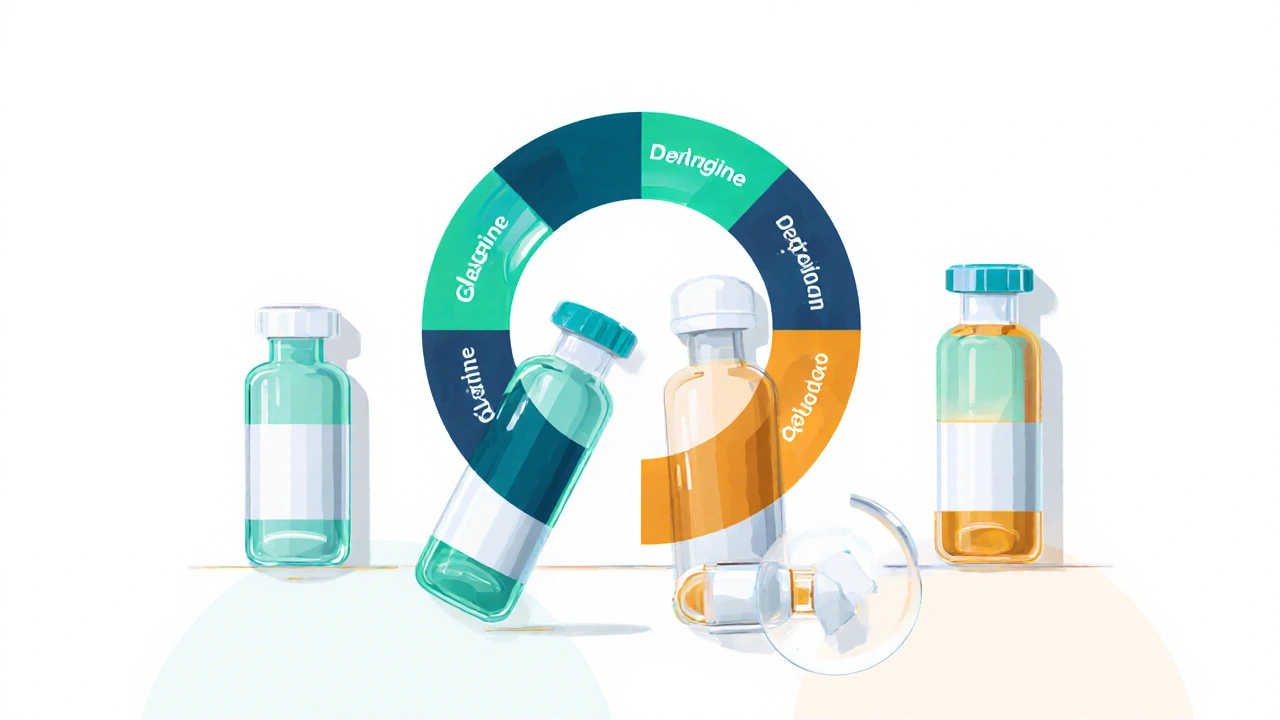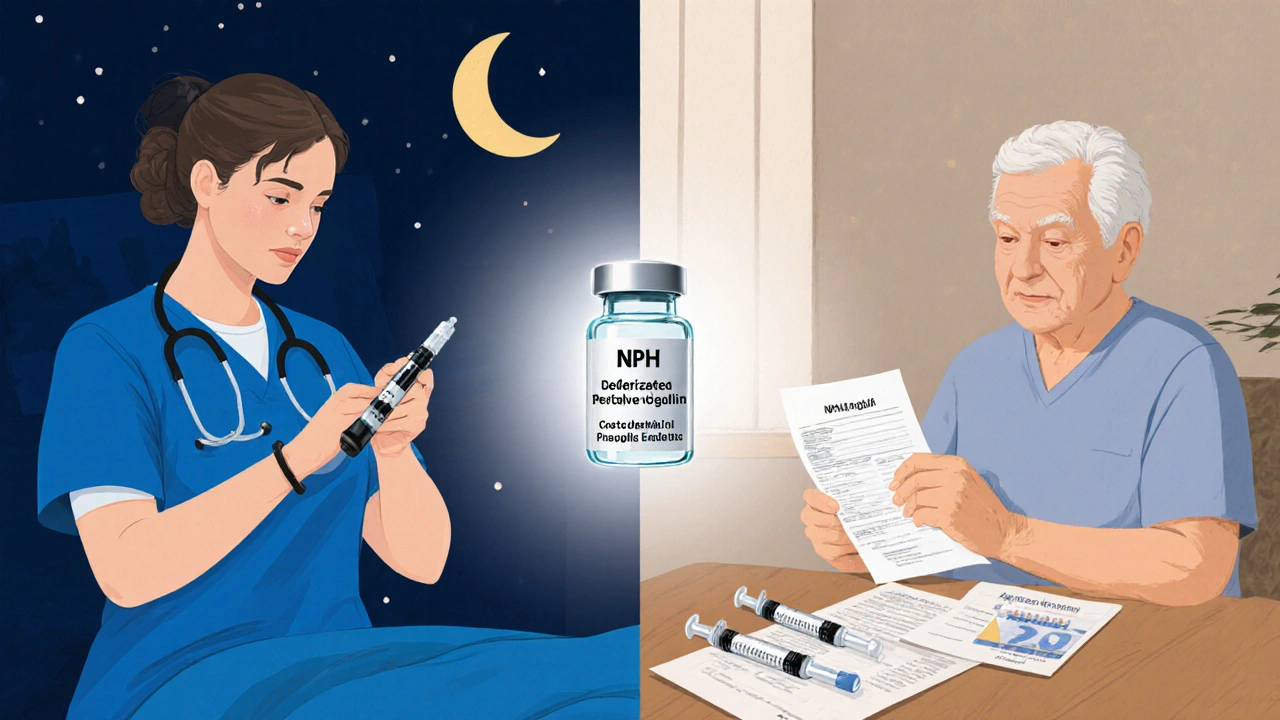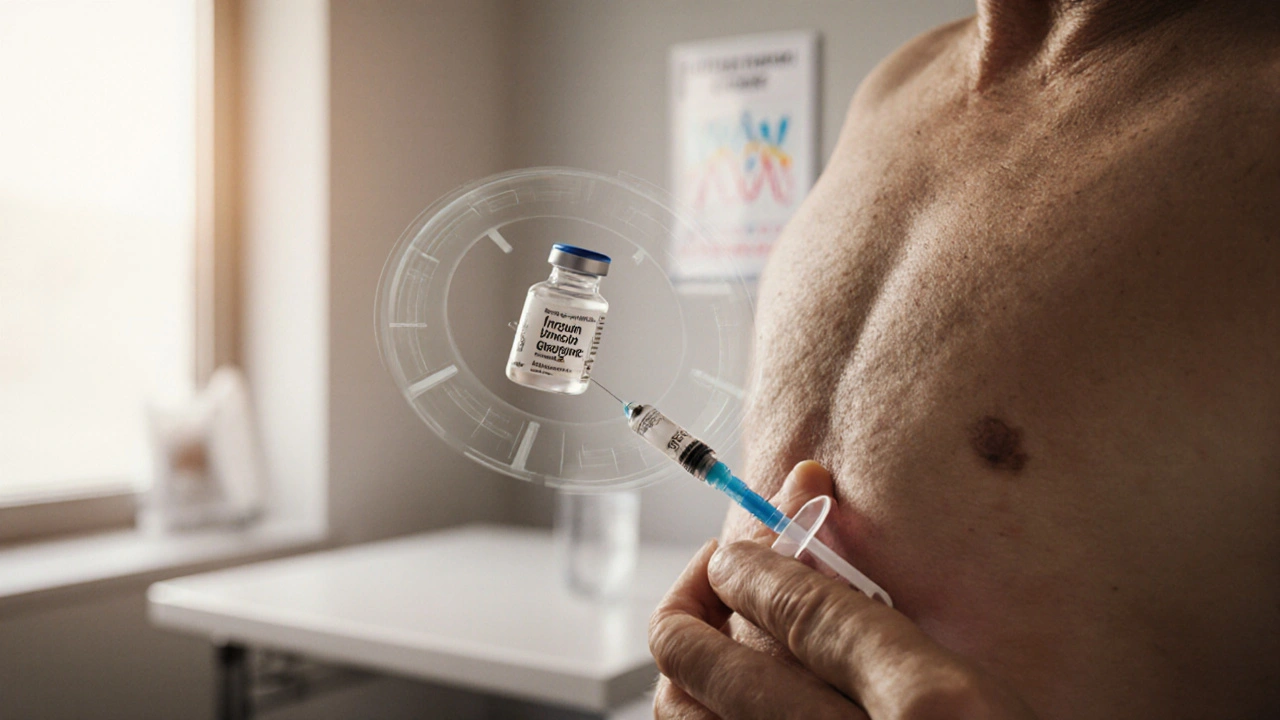Basal Insulin Comparison Tool
This tool helps compare key characteristics of different basal insulins to understand their differences in duration, peak time, and suitability for various patient needs.
Insulin Glargine
Lantus
- Duration: 24 hours
- Peak: Minimal
- Usage: Once daily
Insulin Detemir
Levemir
- Duration: 14-18 hours
- Peak: Minimal
- Usage: Twice daily
Insulin Degludec
Tresiba
- Duration: Up to 42 hours
- Peak: Minimal
- Usage: Once daily
NPH Insulin
Neutral Protamine Hagedorn
- Duration: 18-24 hours
- Peak: Pronounced
- Usage: Twice daily
Comparison Table
| Characteristic | Insulin Glargine | Insulin Detemir | Insulin Degludec | NPH Insulin |
|---|---|---|---|---|
| Duration | 24 hours | 14-18 hours | Up to 42 hours | 18-24 hours |
| Peak Time | Minimal | Minimal | Minimal | Pronounced (4-12 hours) |
| Dosing Frequency | Once daily | Twice daily | Once daily | Twice daily |
| Hypoglycemia Risk | Low | Low | Low | High |
| Cost | Moderate | Moderate | Higher | Lowest |
Patient Suitability Guide
Best for:
- Insulin Glargine: Patients seeking consistent 24-hour coverage with minimal peaks
- Insulin Detemir: Those needing twice-daily dosing or who prefer a slightly shorter duration
- Insulin Degludec: Patients requiring maximum flexibility in injection timing
- NPH Insulin: Budget-conscious patients with lower risk tolerance for hypoglycemia
Considerations:
- Insulin Glargine: May require dose adjustments for certain populations
- Insulin Detemir: Requires twice-daily administration
- Insulin Degludec: More expensive but offers extended duration
- NPH Insulin: Higher risk of nighttime hypoglycemia due to pronounced peaks
Key Takeaways
- Insulin Glargine provides a flat, 24‑hour glucose‑lowering profile with low night‑time peaks.
- Insulin Detemir is slightly shorter‑acting; dosing may need twice‑daily injections for some patients.
- Insulin Degludec offers the longest duration (up to 42 hours) and greatest flexibility in timing.
- NPH insulin is the cheapest basal option but shows pronounced peaks and higher hypoglycemia risk.
- Choosing the right basal insulin depends on lifestyle, HbA1c goals, hypoglycemia tolerance, and cost considerations.
What Is Insulin Glargine?
Insulin Glargine is a long‑acting basal insulin analogue that mimics the body’s natural background insulin. It is formulated to precipitate slowly after subcutaneous injection, releasing a steady amount of insulin over roughly 24 hours with minimal peaks. First approved in 2000, Glargine (often sold under the brand name Lantus) has become a cornerstone for both Type1 and Type2 diabetes management.
How Does Insulin Glargine Work?
Glargine’s molecular tweaks shift its isoelectric point, causing it to form micro‑precipitates in the tissue. These precipitates dissolve gradually, delivering a constant insulin level that keeps fasting blood glucose stable. Because it lacks a pronounced peak, patients experience fewer night‑time lows compared with older basal insulins.

Common Alternatives to Insulin Glargine
Several other basal insulins compete with Glargine. Below are the most frequently prescribed alternatives.
Insulin Detemir
Insulin Detemir is another basal analogue introduced in 2004. It binds tightly to albumin, which slows its absorption and creates a relatively flat profile, though its duration (typically 14‑18hours) often requires twice‑daily dosing for optimal control.
Insulin Degludec
Insulin Degludec pushes the envelope on duration, lasting up to 42hours. Its ultra‑long action provides flexibility-patients can vary injection timing by several hours without losing efficacy.
NPH Insulin
NPH Insulin (neutral protamine Hagedorn) is an older, intermediate‑acting insulin. It peaks between 4‑12hours post‑dose and lasts about 18‑24hours, leading to a higher risk of hypoglycemia, especially overnight.
Basal Insulin (Category)
Basal Insulin refers to any long‑acting insulin used to control glucose levels in between meals and overnight. All the agents above belong to this category.
Diabetes Mellitus Type1
Diabetes Mellitus Type1 is an autoimmune condition where the pancreas produces little or no insulin, making basal insulin essential for survival.
Diabetes Mellitus Type2
Diabetes Mellitus Type2 involves insulin resistance and often a gradual decline in insulin production. Basal insulin can be added when oral agents no longer achieve target HbA1c.
HbA1c
HbA1c measures average blood glucose over the past 2‑3months. Most clinicians aim for <7% (53mmol/mol) in non‑pregnant adults, though individual targets vary.
Side‑by‑Side Comparison
| Attribute | Insulin Glargine | Insulin Detemir | Insulin Degludec | NPH Insulin |
|---|---|---|---|---|
| Duration of action | ≈24hours (once‑daily) | 14‑18hours (often twice‑daily) | Up to 42hours (once‑daily) | 12‑18hours (once‑daily) |
| Peak effect | Minimal | Low, but detectable | Very low | Pronounced (4‑12h) |
| Hypoglycemia risk (night) | Low | Moderate | Very low | High |
| Typical dose flexibility | ±2hours | ±1hour | ±8hours | Fixed time |
| Cost (US, 2025) | $300‑$350 / vial | $260‑$310 / vial | $380‑$430 / vial | $100‑$130 / vial |
| Typical use | Both Type1 & Type2 | Both, often in children | Both, especially for flexible schedules | Both, when budget constraints exist |
Decision Criteria: Which Basal Insulin Fits Your Lifestyle?
When you sit down with your clinician, ask about these five factors.
- Injection schedule tolerance: If you travel frequently or work night shifts, Degludec’s wide timing window may be a lifesaver.
- Hypoglycemia concerns: Patients with a history of nocturnal lows often prefer Glargine or Degludec over NPH.
- Cost and insurance coverage: In many countries, NPH remains the most affordable basal, but newer analogues may be covered with co‑pay assistance.
- Weight impact: Studies show similar weight gain across analogues; real‑world data suggest Detemir may cause slightly less gain for some users.
- Renal or hepatic function: All basal insulins are cleared primarily by the liver and kidneys; dose adjustments are required as function declines, but no agent is contraindicated.

Practical Tips for Switching Basal Insulins
Transitioning doesn’t have to be a gamble. Follow this simple roadmap.
- Calculate your current total daily basal dose (TDBD) in units.
- For Glargine→Detemir, start at 80‑90% of TDBD because Detemir is slightly less potent per unit.
- For Glargine→Degludec, you can usually keep the same unit dose, then monitor fasting glucose for the first two weeks.
- When moving to NPH, split the dose into two injections (morning and bedtime) to smooth out the peaks.
- Check fasting glucose daily for the first week and adjust by 2‑4units as needed.
- Document any hypoglycemia episodes and discuss them at your next appointment.
Common Misconceptions
Myth: “All basal insulins are interchangeable.”
Reality: While they all lower glucose, differences in duration, peak, and flexibility mean a blind swap can cause highs or lows.
Myth: “Long‑acting = more expensive for everyone.”
Reality: Pricing varies by country, pharmacy contracts, and insurance tiers. In some health systems, Glargine is listed as a first‑line option because of its proven safety profile.
Myth: “You can stop mealtime insulin if you have a strong basal.”
Reality: Basal insulins control background glucose; they don’t cover post‑prandial spikes. You’ll still need rapid‑acting insulin or other agents for meals.
Next Steps and Troubleshooting
If you’re already on Glargine and think another basal might suit you better, start by gathering recent HbA1c results, average fasting glucose logs, and any recorded hypoglycemia episodes. Bring these to your next endocrinology visit. Talk specifically about your daily routine - early mornings, night shifts, or irregular meals - because that information guides the clinician toward the most compatible analogue.
If you experience persistent lows after a switch, consider:
- Reducing the dose by 10‑15%.
- Adjusting injection timing (e.g., moving a Glargine dose earlier in the evening).
- Reviewing concurrent medications that can potentiate insulin (e.g., sulfonylureas).
Always keep a rapid‑acting insulin or glucose tablets on hand during any change period.
Frequently Asked Questions
Can I use Insulin Glargine once daily for Type2 diabetes?
Yes, most adults with Type2 diabetes can achieve target fasting glucose with a once‑daily Glargine dose, especially when combined with oral agents or GLP‑1 receptor agonists.
Is Insulin Degludec safe for pregnant women?
Degludec is classified as pregnancy category C. While some studies suggest it’s well‑tolerated, most clinicians still prefer Glargine or Detemir for pregnant patients due to longer safety records.
Why does NPH cause night‑time lows?
NPH peaks 4‑12hours after injection. If you inject at bedtime, the peak often occurs during sleep, raising the chance of nocturnal hypoglycemia.
Do basal insulins affect weight?
All insulin therapy can lead to modest weight gain because it improves glucose utilization. The amount varies more with lifestyle and total daily dose than with the specific basal insulin.
How often should I rotate injection sites?
Rotate within the same region (abdomen, thigh, buttock, upper arm) for each injection to avoid lipohypertrophy. A simple rotation pattern-clockwise or by quadrant-works well.

Susan Rose
October 5, 2025 AT 16:07I've been on Lantus for a few years now, and the flat 24‑hour profile really helps keep my mornings steady. The minimal peak means I don't get those dreaded nighttime lows that I used to see with NPH. If you're juggling a busy schedule, the once‑daily dosing is a lifesaver.
diego suarez
October 6, 2025 AT 12:58Basal insulins each have a niche; glargine offers consistent coverage, detemir fits a twice‑daily routine, and degludec gives extra timing flexibility. Choosing the right one depends on lifestyle and how your body responds.
Eve Perron
October 7, 2025 AT 09:49When evaluating basal insulin options, it is essential to begin with a clear understanding of pharmacokinetic profiles, as these dictate both efficacy and safety; insulin glargine, for instance, maintains a relatively flat serum concentration over approximately twenty‑four hours, thereby minimizing the risk of nocturnal hypoglycemia. In contrast, insulin detemir, bound tightly to albumin, typically provides a duration of fourteen to eighteen hours, which often necessitates a twice‑daily regimen to achieve optimal glycemic control. Insulin degludec, distinguished by its ultra‑long action extending up to forty‑two hours, offers unprecedented flexibility, allowing patients to vary injection times by several hours without compromising therapeutic effect. NPH insulin, while economical, exhibits a pronounced peak between four and twelve hours post‑injection, a characteristic that can precipitate significant glucose excursions, particularly during the night. Moreover, the cost considerations are non‑trivial; while glargine and detemir are priced at moderate levels, degludec’s advanced formulation commands a higher price point, whereas NPH remains the most affordable option. Clinical guidelines frequently recommend glargine as a first‑line basal agent for individuals who prioritize a low hypoglycemia risk and prefer once‑daily dosing. However, patients with renal impairment or those prone to weight gain may benefit from detemir’s modest weight‑neutral profile. The choice of basal insulin also intersects with patient adherence; a simpler dosing schedule often translates to better compliance, yet some individuals value the ability to adjust timing, a feature degludec uniquely fulfills. It is also worth noting that immunogenicity concerns, although rare, have been documented with certain analogues, underscoring the importance of individualized monitoring. In practical terms, a comprehensive assessment should incorporate HbA1c targets, lifestyle patterns, comorbid conditions, and financial constraints, all of which influence the ultimate selection. Education on injection technique and site rotation remains vital across all basal insulins to mitigate variability in absorption. Finally, the evolving landscape of biosimilar glargine products promises to expand accessibility, potentially reshaping cost dynamics in the near future. By synthesizing these multifaceted considerations, clinicians can tailor basal insulin therapy to each patient’s unique physiological and psychosocial context, thereby optimizing outcomes and quality of life.
Josephine Bonaparte
October 8, 2025 AT 06:40Yo, if ur still stuck on NPH, get outta that cheap trap-glargine's way safer and way less hassel for night lows! Stop wasting time.
Meghan Cardwell
October 9, 2025 AT 03:31From a pharmaco‑dynamic standpoint, glargine's monomeric release kinetics confer a quasi‑steady‑state insulin milieu, which is a boon for patients seeking glycemic equilibrium without the 'roller‑coaster' associated with intermediate‑acting formulations. In layman’s terms, think of it as a steady drizzle rather than a sudden downpour.
stephen henson
October 10, 2025 AT 00:22Great summary! 😊
Manno Colburn
October 10, 2025 AT 21:13i think we should reall think about how these insulins are not just numbers on a table, they are part of daily rituals that shape our sense of control, and sometimes people ignore the subtle nuance of how a 42 hour drug like degludec can actually give you the power to mess up your schedule less, but at the same time, it's a wild beast that might lead to complacency, and i dont want to sound like i'm makin a big drama out of it, but the truth is that many docotrs dont talk about the cost impact enough, and patients end up feeling betrayed when they see the bill, so yeah, just think about it.
Namrata Thakur
October 11, 2025 AT 18:04It's wonderful to see how each basal insulin can be matched to a person's life-whether you need simplicity, like with glargine, or flexibility, like with degludec, there's a good fit out there for everyone.
Chloe Ingham
October 12, 2025 AT 14:55Don't you see? The pharma giants are pushing the newest shiny insulin while hiding the cheap, effective options. They're playing a game with our health.
Mildred Farfán
October 13, 2025 AT 11:46Oh sure, because nothing says "I love my diabetes management" like spending extra bucks on a fancy insulin that does the same thing as the older one-great job, industry.
Danielle Flemming
October 14, 2025 AT 08:37Hey folks! 🌟 If you’re hunting for a basal that slides into your routine like butter on toast, glargine’s the smooth operator-steady, reliable, and totally hassle‑free.
Anna Österlund
October 15, 2025 AT 05:28Listen up, if you’re not on glargine yet you’re basically sabotaging your own health-step up and get that consistent coverage now.
Brian Lancaster-Mayzure
October 16, 2025 AT 02:19From what I’ve seen, patients often appreciate the predictability of a once‑daily basal, especially when they have unpredictable schedules.
Erynn Rhode
October 16, 2025 AT 23:10While the comparative table succinctly outlines the primary pharmacodynamic attributes of each basal insulin, a deeper dive reveals nuanced considerations such as inter‑patient variability in absorption, the impact of concomitant medications, and the subtle differences in immunogenic potential that may influence long‑term therapy decisions; moreover, clinicians should weigh the psychosocial aspects, recognizing that a once‑daily regimen like glargine may enhance adherence, yet for some individuals, the flexibility offered by degludec could prove indispensable in accommodating shift work or irregular meal patterns, ultimately underscoring the necessity of a personalized approach that transcends mere cost analysis.
Rhys Black
October 17, 2025 AT 20:01It is undeniably a moral imperative to eschew the cheap, archaic NPH insulin, for persisting with such a primitive formulation not only endangers patient safety but also reflects a regrettable complacency in the face of medical advancement.
Abhishek A Mishra
October 18, 2025 AT 16:52For anyone wondering how to pick the right basal, consider your daily routine, how often you can remember to inject, and discuss the cost with your provider to find a balance that works for you.
Jaylynn Bachant
October 19, 2025 AT 13:43Life is like insulin, sometimes you need a steady drip, other times a burst-choose what fits your soul's rhythm.